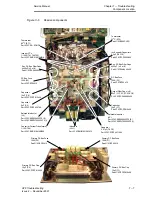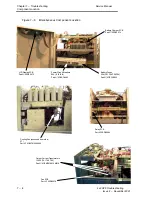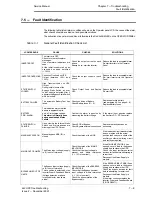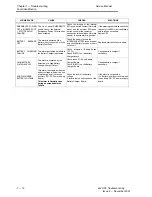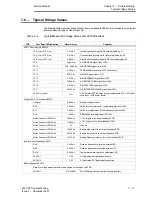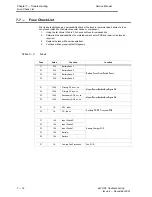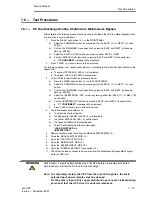
Service Manual
Chapter 6 - Maintenance
Battery Maintenance
6 - 8
3x3 UPS Maintenance
Issue 2 - November 2001
a)
White deposits around the terminal seals which indicate seal failure.
Replace any batteries found.
2.
Check the security of the terminal connections. Examine for signs of corrosion or
overheating.
3.
Inspect battery cases for distortion, splits or bulges.
a)
Batteries near the end of their effective life, will exhibit bulges in the case, due to
increasing pressure of the positive plates as they grow in size.
b)
Severe distortion may also be apparent, caused by the higher resistance of the corroded
plates, which tends to generate heat during charge and discharge. In turn the plastic of
the case will creep and failure of a single cell will cause the side of that cell to bulge.
c)
Total end of life condition will normally cause all cells to bulge or distort.
6.2.3 - Battery capacity testing.
There are generally two ways in which the capacity of a battery can be tested by impedance measureĆ
ment, or by load testing.
Impedance measurement
Measurement of the battery AC impedance requires special test equipment, but gives a measure of how
the battery impedance has changed since new. Any battery that has been on continuous float charge
prior to the test, should not exhibit more than twice the new battery value.
Values in excess of this, indicate the battery is nearing the end of its effective life, while batteries exhibitĆ
ing 4 or more Swiss the new value, need immediate replacement.
This test will only look at the battery level and not the individual cell level, therefore, a cell with above
normal impedance to the others, will not be indicated.
Discharge test
The more common method of determining the capacity and serviceability of the batteries, is to carry out
a discharge test.
A suitable resistor designed to draw a current equal to the Ah size of the battery is placed across the
battery terminals. The battery terminal voltage is then monitored.
A fairly large wattage, 5 W resistor capable of taking 11A is connected across the battery terminals. After
10 minutes discharge, the battery terminal voltage should not fall below 11.2 V indicating the 50% capacĆ
ity level.
If a battery has high internal resistance and reduced capacity the terminal voltage will fall quickly.
Batteries with a capacity above 50% may continue to be used, but will reduce the autonomy of the sysĆ
tem. It is recommended that they be replaced, however batteries below 50%, should always be reĆ
placed.
Note: A higher resistance value, discharge resistor may be used to discharge
the battery. The terminal voltage measured will then give an indication of
the serviceability of the battery, but is not an accurate measure of the
battery capacity.
























